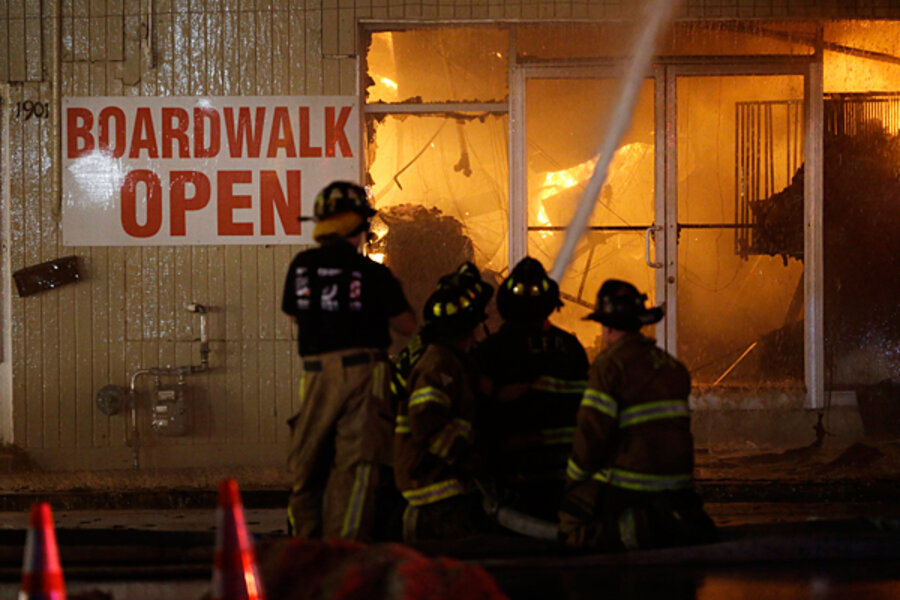Jersey shore tourism struggles: first superstorm Sandy, now a tornado of fire
Loading...
| New York
Less than a year after superstorm Sandy devastated a famous stretch of New Jersey’s boardwalks – leaving local businesses in a ruin of splintered boards, mangled steel, and a blanket of sea-swept sand – the tornado of fire that this week swept through four blocks of the area’s just-rebuilt arcades and restaurants has burned nearly every business to the ground.
The flames destroyed some 50 businesses along an iconic stretch of the state’s numerous boardwalks, which run along its 130 miles of ocean coastline.
Indeed, Seaside Park and Seaside Heights became national emblems of Sandy’s ravages. Particularly prominent were images of the twisted JetStar roller coaster, which had been swept off its moorings and left isolated a few hundred feet into the ocean. It was finally dismantled this May.
“After all the effort and time and resources that we’ve put in to help the folks in Seaside Park and Seaside Heights rebuild – to see this going on is just unthinkable,” said New Jersey Gov. Chris Christie (R). “So, I know how I feel, and I can only imagine how the residents and business owners in this area are feeling.
“My heart goes out to them,” he continued. “That’s why I’m here, to make sure that every resource is brought to bear to contain this problem. And, listen, this is us, you know, so as soon as this is over, we’ll pick ourselves up, we’ll dust ourselves off, and we’ll get back to work.”
Yet the dust and smoldering embers from the wind-borne flames come just months after the millions of dollars poured into these Sandy-ravaged communities, which rely on tourism.
On average, Seaside Heights takes in about $1.2 million from beach badge sales a year – one marker of the number of visitors every year. This dollar figure spiked during the pre-Sandy summers when the hit MTV reality show “Jersey Shore” brought thousands of new visitors.
By this August, however, sales were only near $800,000, according to Seaside Heights borough administrator John Camera, as reported by the Newark Star-Ledger.
“Seaside Heights was not able to rebound the way other communities along the Jersey shore did because it was hit by Hurricane Sandy harder than any other area,” e-mails David Fiorenza, an economist at Villanova University School of Business in Pennsylvania. “Rentals were down this summer as the boardwalk and attractions were not ready. If this horrible fire did not hit [Thursday], Seaside Heights would have been able to rebound by next summer.”
Of the town’s $12 million annual budget, $7 million is drawn from summer tourism, according to Seaside Heights officials.
“I would say we were probably 30 to 35 percent off this summer,” says Ron Rinaldi, a manager at the Sawmill Café. The restaurant is the lone business left standing in the area, according to Mr. Rinaldi, who witnessed the fire as it spread.
“Most of the other businesses on the boardwalk were probably off more” this summer, he says. “I mean, we were lucky. We’re a large restaurant with a liquor license, and we have indoor seating.”
The fire began 10 feet north from Sawmill at Kohr’s Frozen Custard, an ice-cream stand that has been part of the Seaside communities since 1919.
“It was the perfect storm,” Thomas Boyd, Seaside Heights police chief, told MSNBC’s “Morning Joe.” “You had hot tar roofs, you had fire, and you had 30 mile-per-hour winds. So I just knew it was going to go that quick.... I’m waiting for the frogs and locusts to come now,” he said, referring to the biblical plagues.
On Friday, Governor Christie said the area "provided generations of memories for our citizens" – and would do so again.
"We will restart the rebuilding as soon as possible," he said. "We are tough, and we stand together in a crisis."
But some local business leaders see a long road ahead.
“Where do they go, how do they recover?” says Jack Purvis, a Jersey shore resident and president of the New Jersey chapter of the American Institute of Architects. “You know, it’s tough. They probably just spent most of their insurance money they had from Sandy to rebuild what they have now, and now they have to do it again. It has to be pretty heartbreaking.”
Most of the structures in the area, even after being renovated after Sandy, date back to the 1960s and earlier, notes Mr. Purvis, who sold hot dogs and sausage sandwiches in Seaside Heights as a teenager in the ’60s.
“But in the process of rebuilding this, they have an opportunity to rebuild these businesses to the current code requirements and look at buildings getting sprinklers, and upgrading the water services that come into these areas,” he says. “Building them with fire partitions, protecting the structure – life safety things which are really the most important. With things like this, you can improve them in the recovery.”
The cost to rebuild this section of the boardwalk would be about $600,000, according to Bob Martucci, Seaside Park’s borough administrator. He didn’t know how much it would cost to rebuild the ruined businesses, however.






